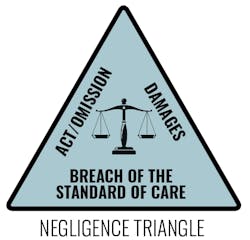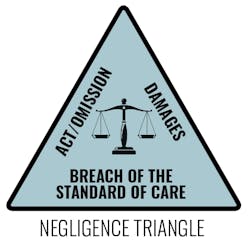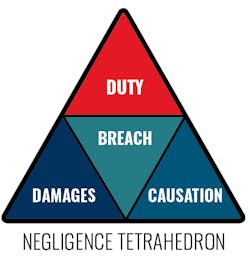Fire Law: The Negligence Triangle and the Negligence Tetrahedron
One of the challenges of teaching law to firefighters is making it understandable without oversimplifying it. Oversimplification can lead to misunderstandings or can make the information so generalized that it is of little use.
Negligence is an important concept for firefighters. Beyond being a common form of liability, it provides a basis for evaluating the services that a department provides measured against the standard of care. Negligence has both civil and criminal aspects. In this column, the focus is on the civil aspect and, in particular, the tort of negligence.
The elements of negligence
There are different definitions of negligence, but the one that’s most applicable to firefighters is the failure to exercise the care that a reasonably prudent person would have exercised under the circumstances, which causes damages to another.
Beyond the definition of the term are the elements of negligence. Think of elements as a checklist. Negligence potentially has two sets of elements, one tha has three steps (the simple) and one that has four (the more precise). As such, we can draw a parallel to the fire triangle and the fire tetrahedron.
The fire triangle is a useful tool to help us to understand the three legs of fire (fuel, heat and oxygen), while the fire tetrahedron provides for a more advanced insight by adding the chemical chain reaction. In either case, remove one leg and the fire goes out.
In the same way, negligence can be looked at as either a triangle or a tetrahedron.• Act/omission. An act can be any affirmative act, such as driving a car, cooking a meal and operating a chainsaw. When performing an act, the actor is under a duty to exercise reasonable care to anyone who may foreseeably be harmed. An omission is the failure to act when one is under a legal duty to act. A duty to act may arise from a statute (duty to report child abuse) or a relationship between the parties (doctor to patient, lifeguard to swimmer).
• Damages. The act or omission causes harm to the victim in terms of personal injury or property damage. An associated concern is that the act/omission be the proximate (legal) cause of the harm.
• Breach of the standard of care. The act/omission fails to meet the applicable standard of care. The ordinary standard of care is what the reasonably prudent person would have done under the circumstances. A person who has special expertise, such as a firefighter and medic, is held to the standard of care of what the reasonably prudent professional of like skill and training has done under the circumstances.
The negligence triangle provides a relatively simple framework that’s perfect for training firefighters. However, the negligence tetrahedron is more in line with howThe four elements of the negligence tetrahedron are duty, breach, damages and causation:
• Duty. A duty to exercise reasonable care arises when one acts, such as when driving a car, cooking a meal and operating a chainsaw. An affirmative duty to act with reasonable care may arise from a statute or relationship, and failing to do so would be an omission. Those who have a special expertise, such as a firefighter and medic, have a duty to exercise the care of the reasonably prudent professional of like skill and training when acting in that capacity.
• Breach. Breach refers to the breach of the legal duty.
• Damages. The breach of the duty causes actual harm to the victim in terms of personal injury or property damage.
• Causation. The breach of the duty is the proximate cause of the harm that occurs.
Differences of the models
Obvious differences exist between the fire triangle/tetrahedron models and the negligence triangle/tetrahedron models—for example, the fact that the negligence tetrahedron is not built by simply adding one additional element to the negligence triangle. Rather, the negligence tetrahedron is an alternative approach to negligence that uses four elements that overlap with, but are different from, the negligence triangle.
The negligence tetrahedron aligns with the way courts approach negligence due to an important distinction between questions of law and questions of fact. In court, questions of law are decided by judges. In a negligence case, the judge determines the legal duty owed. Questions of fact are decided by juries and include whether the duty was breached. Notice that the negligence triangle merges these two issues, whereas the negligence tetrahedron keeps them distinct. These differences aside, remove one element from either the triangle or tetrahedron and it is not actionable negligence.
Triangle or tetrahedron?
Attorneys and judges use the four-element definition of negligence. Because it is more complicated than the negligence triangle, the negligence tetrahedron can cause confusion for people who aren’t lawyers when they read cases. However, like the fire triangle, the negligence triangle suffices to explain the fundamentals and, thus, is a wise choice for training firefighters. Those who teach advanced courses in fire service law ought to consider presenting both models, particularly when training chief officers, who are more likely to interreact with legal counsel on a regular basis.
About the Author

Curt Varone
CURT VARONE has more than 40 years of experience in the fire service, including 29 years as a career firefighter with Providence, RI, retiring as a deputy assistant chief (shift commander). He is a practicing attorney who is licensed in Maine and Rhode Island and served as the director of the Public Fire Protection Division at the NFPA. Varone holds a master's degree in forensic psychology from Arizona Statue University. He is the author of two books, "Legal Considerations for Fire and Emergency Services" and "Fire Officer's Legal Handbook," and remains active as a deputy chief in Exeter, RI. Varone is a member of the Firehouse Hall of Fame.




